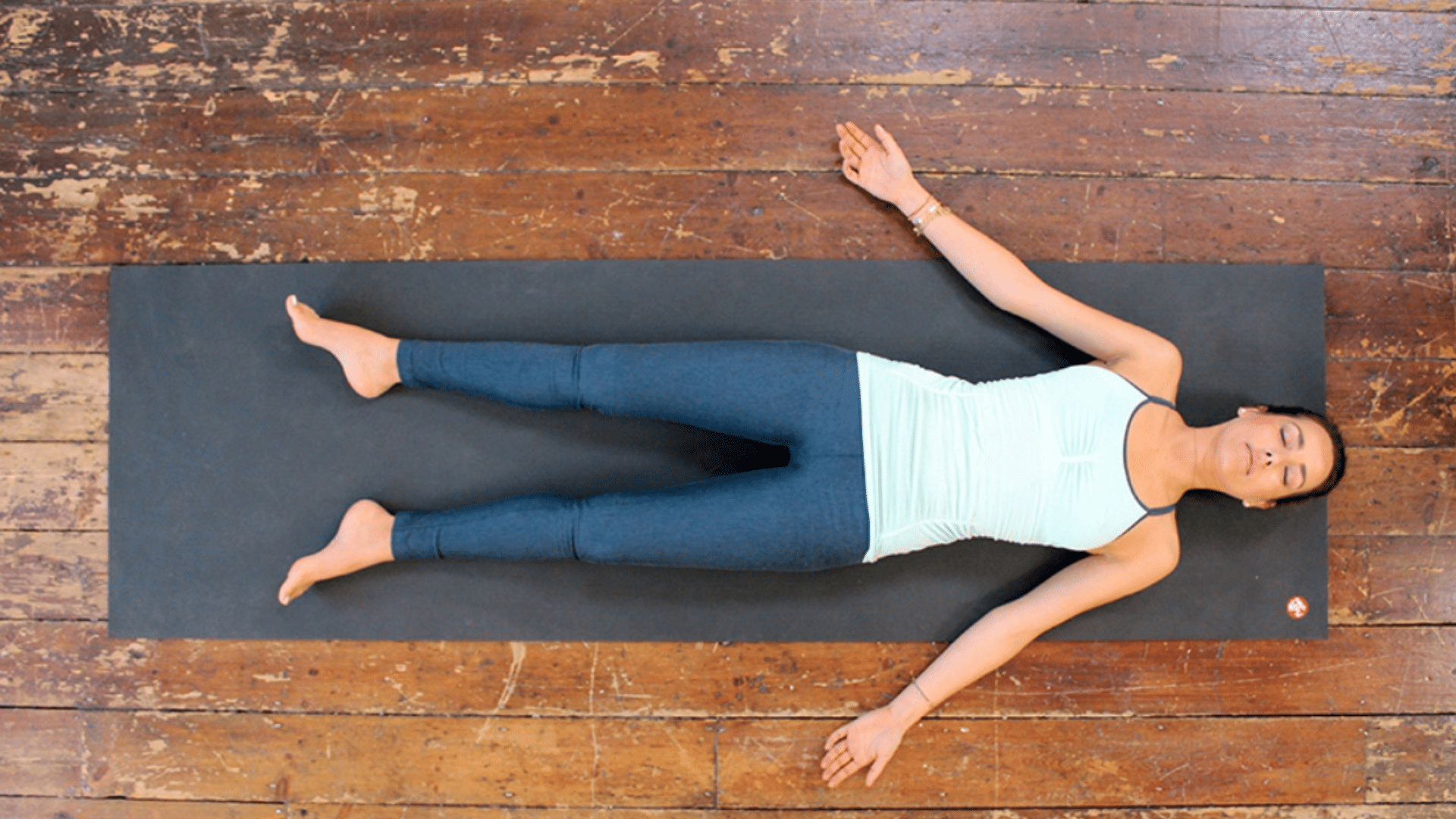You’ve probably seen people lying flat at the end of a yoga class and wondered what’s going on there.
I used to think it was just a rest pose, too, until I understood the true meaning of shavasana.
It’s not just about being still. It’s where everything in your body and mind comes together. You stop pushing, thinking, fixing, and just be.
That quiet moment? It can change how you feel for the rest of the day. Want to see what’s possible in stillness?
Understanding the Meaning and Benefits of Shavasana
Shavasana comes from the Sanskrit words shava (corpse) and asana (posture), which together mean “corpse pose.”
At the end of a yoga session, you lie still on your back like a resting body, but the goal isn’t sleep; it’s conscious relaxation.
This pose encourages complete physical stillness and mental release, helping you let go of effort, judgment, and tension.
It’s not just about resting. Shavasana helps your body absorb the benefits of your practice and prepares your mind to return to life calm, aware, and centered.
Shavasana helps you relax, restore energy, and calm your mind, so I can guide you into deeper awareness.
1. Physical and Mental Relief
Shavasana helps your body slow down and reset. It activates the rest-and-digest mode of your nervous system, which lowers blood pressure and calms your heart rate.
Muscles release built-up tension, and your mind gets a quiet break. This gentle pause after movement gives your whole system a chance to recharge, making you feel less drained and more clear-headed, both on and off the mat.
2. Emotional and Spiritual Balance
Lying still in Shavasana can help you let go of emotional stress. It gives you space to feel what’s going on inside without reacting to it. That quiet awareness enables you to stay calmer, not just during yoga, but in daily life too.
Over time, the pose also teaches acceptance and surrender. You stop needing to fix or chase things, and instead learn to be still with whatever is happening.
How to Practice Shavasana (Step-by-Step)


Learn how to set up Shavasana so you can relax fully while I guide you through each simple step.
Step 1: Lie Down and Get Comfortable
Lie flat on your back with your legs slightly apart and arms at your sides, palms facing up. Let your feet fall open naturally. Adjust your clothes, hair, or makeup if needed.
The goal is to feel fully supported by the ground so you can begin letting go without needing to fidget.
Step 2: Relax Your Whole Body
Begin with your toes and slowly relax each part of your body, starting from your feet, legs, hips, belly, chest, hands, arms, shoulders, neck, and face. Let every area soften as you move upward.
Don’t force anything, just notice and release. As your body settles, your breath will slow, and your mind will start to quiet down naturally.
Step 3: Focus on Your Breath
Bring your attention to your natural breath. Feel it move in and out without changing it. Let your breath be soft and steady, like gentle waves.
If your thoughts wander, gently come back to the feeling of air entering and leaving your body. This simple focus helps keep your mind calm and your body still.
Step 4: Stay Present and Let Go
Now that your body is still and your breath is steady, allow yourself to rest fully. Let go of any effort to do or think. If thoughts come, let them pass like clouds.
Don’t judge or chase them. Just stay present in your body and enjoy this time of complete release and awareness.
For more explicit clarification, watch this video:
How to Use Shavasana Anytime
You don’t need a complete yoga session; I’ll show you how to use Shavasana anytime to help you reset, recharge, and relax deeply.
5-Minute Mid-Day Reset
Take a short break by lying on the floor or reclining in a chair. Close your eyes and bring your focus to slow, steady breathing. Soften your shoulders, unclench your jaw, and relax your belly.
Even a few minutes like this can calm your nervous system, clear your head, and leave you feeling more focused, refreshed, and less reactive for the rest of your day.
Bedtime Wind-Down
Before sleep, set up a quiet space with dim lighting. Lie down and place a pillow under your knees for back support. Let your arms rest gently at your sides. Focus on slow, deep breathing.
Let each breath guide your body into stillness. This calming version of Shavasana helps release physical tension and quiet your mind so you can fall asleep more easily and rest more deeply.
Post-Workout Recovery
After a workout, finish with Shavasana to help your body recover. Lie on your back and allow your muscles to settle. Take steady breaths and feel the ground support you.
This pause lowers your heart rate, supports better circulation, and gives tight areas time to release. It’s an easy way to prevent soreness and help your body shift into recovery mode before moving on with your day.
Shavasana Variations for All Ages


I’ll help you find a Shavasana position that fits your body so you can relax comfortably, no matter where you are.
For Pregnant Practitioners
During pregnancy, lying flat can feel uncomfortable or restrict breathing. Try a side-lying Shavasana with a pillow between your knees and ankles for support. Use a bolster or cushion under the belly if needed to relieve pressure.
Keep your head supported and your arms resting gently. This position helps you relax fully while keeping your body safe and supported during each stage of pregnancy.
For Seniors
If lying flat isn’t comfortable or safe, try practicing Shavasana in a reclining chair. You can also lie down with a bolster or rolled blanket under your knees to support the lower back.
Focus on soft breathing and stillness rather than full-body alignment. The goal is comfort. Even short sessions in a supported position can ease tension and support calm, without straining your back, joints, or muscles.
For People With Back Pain
Back discomfort can make it hard to relax in traditional Shavasana. Place a bolster or rolled blanket under your knees to reduce pressure on the lower spine.
You can also bend your knees, plant your feet flat, and let your knees gently fall together. This simple change eases lumbar tension while still allowing your body to rest and reset. Focus on your breath and let the support do the work.
How Long Should You Stay in Shavasana?
The time you spend in Shavasana depends on your practice and what your body needs. After a full 60-minute yoga session, aim for 10 to 15 minutes. If you’ve done a short flow or quick movement session, even five minutes can be enough.
On high-stress days or when you’re feeling burnt out, give yourself up to 20 minutes to reset fully. You can also time your practice around your day. Use Shavasana as a morning energizer, a mid-day reset, or a calming way to wind down before bed.
Common Mistakes and How to Avoid Them
Shavasana seems simple, but it’s easy to miss its full benefit. Here are five things you should watch out for:
- Treating it like nap time: The goal isn’t sleep, but relaxed awareness. Stay mentally present, not zoned out.
- Skipping body cues: Use breath, body scan, or soft focus to stay grounded in the experience.
- Rushing out early: Don’t jump up when class ends. Let the stillness settle first.
- Forgetting to adjust your setup: Props and comfort matter. If you’re fidgeting, you’re not fully resting.
- Skipping Shavasana altogether: Even three quiet minutes can help your body and mind absorb the practice. Don’t miss it.
Shavasana as a Modern Practice of Letting Go
Shavasana isn’t just about lying still; it’s a real-world lesson in softening your grip. It teaches you how to pause, release effort, and be okay with not doing.
There’s no need for spiritual language or deep philosophy. This pose helps you practice letting go of control in a way that feels safe and natural. In stillness, your body resets, but so does your mindset.
It’s a chance to breathe, regroup, and face life again with a little more calm and a lot less pressure.
Conclusion
Now that you understand the real shavasana meaning, I hope it feels less like a pause and more like a reset. It’s your body’s chance to rest deeply, and your mind’s chance to let go.
If you stay for five minutes or twenty, that time on the mat can help you return to life more balanced. If there’s one pose to stick with, it’s this one.
Keep showing up for yourself, stillness included. Want to explore more ways to build calm into your practice? Check out a few of my other yoga-based guides.










